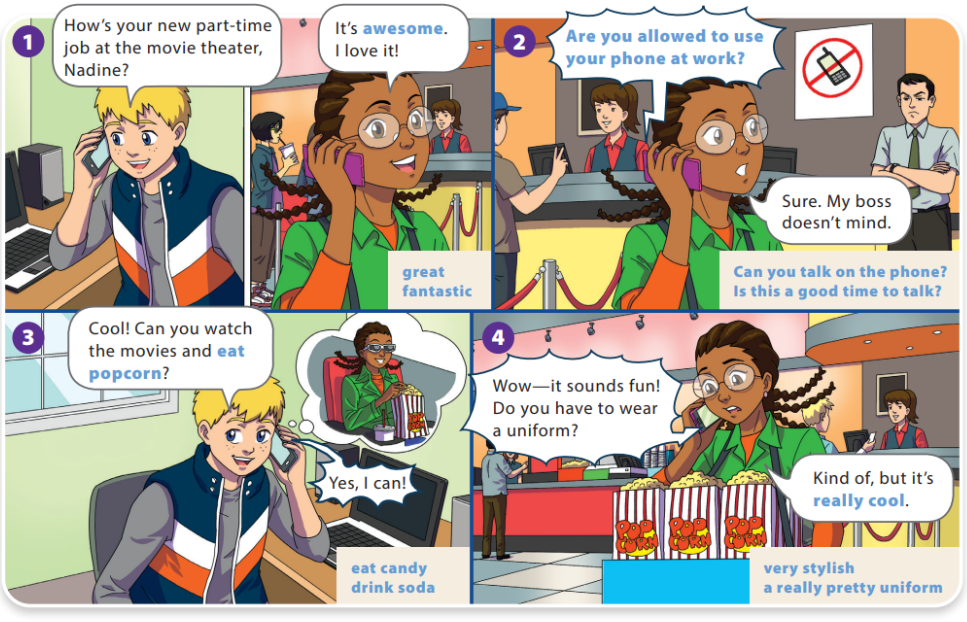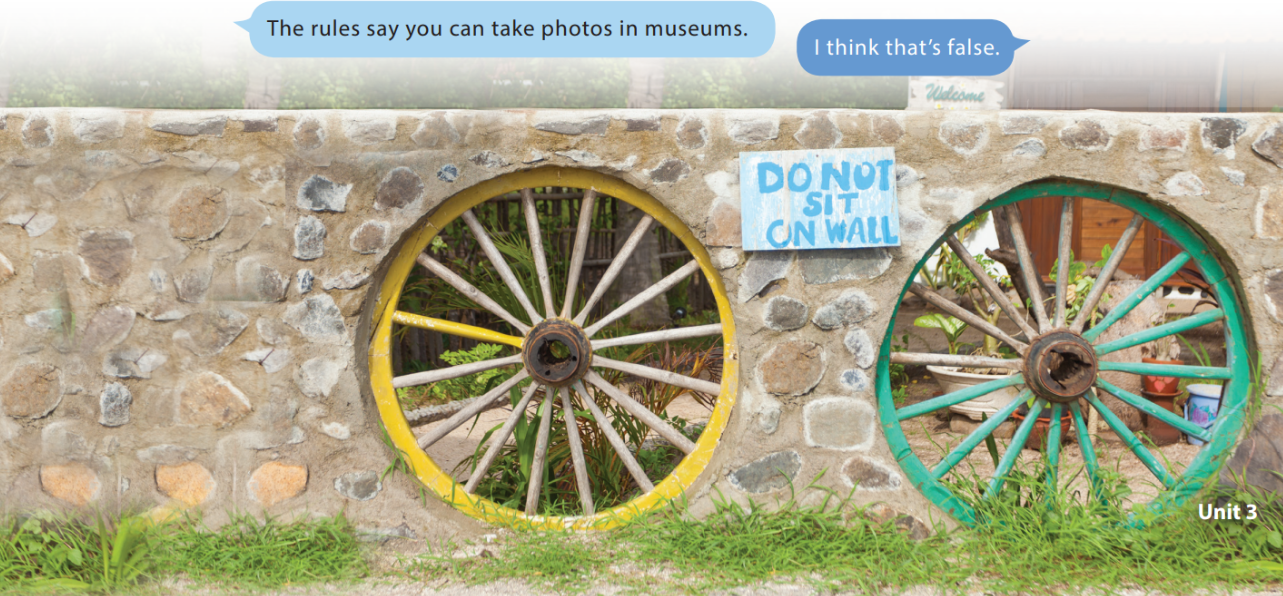Listen and read. Then repeat the conversation and replace the words in blue.

Listen and read. Then repeat the conversation and replace the words in blue.

Practice with a partner. Replace any words to make your own conversation.

1. How’s your new part-time job at the movie theater, Nadine?
It’s ‘wonderful’. I love it!
2. ‘Can you talk on the phone right now?’ - Sure. My boss doesn’t mind.
3. Cool! Can you watch the movies and ‘eat chips’? - Yes, I can!
4. Wow - it sounds fun! Do you have to wear a uniform?
Kind of, but it’s ‘really comfortable’.
Giải thích:
Thay thế các từ phù hợp tương đương với chức năng của loại từ
Cấu trúc: Can + S + V?: ai đó có thể làm gì
Cấu trúc Do/Does + S + V?: ai đó làm gì
Hướng dẫn dịch:
1. Công việc bán thời gian mới ở rạp chiếu phim của bạn thế nào rồi, Nadine?
Rất tuyệt vời'. Tôi thích nó!
2. ‘Bây giờ bạn có thể nói chuyện điện thoại được không?’ - Chắc chắn rồi. Sếp của tôi không bận tâm.
3. Tuyệt vời! Bạn có thể xem phim và 'ăn khoai tây chiên' không? - Vâng tôi có thể!
4. Wow - nghe vui quá! Bạn có phải mặc đồng phục?
Đại loại vậy, nhưng nó ‘thật sự thoải mái’.
Trả lời bởi datcoderRead the rules. Rewrite them using can't or have to.
1. Don't walk on the grass.
2. Stay on the path.
3. Don't feed the animals.
4. Don't play loud music.
5. Recycle your bottles.
6. Walk your bike.
1. You can't walk on the grass.
2. You have to stay on the path.
3. You can't feed the animals.
4. You can't play loud music.
5. You have to recycle your bottles.
6. You have to walk your bike.
Giải thích:
can/can’t + V nguyên thể: có thể/không thể làm gì
have to + V nguyên thể: phải làm gì
Hướng dẫn dịch:
1. Bạn không thể đi trên cỏ.
2. Bạn phải tiếp tục đi trên con đường.
3. Bạn không thể cho động vật ăn.
4. Bạn không thể mở nhạc lớn.
5. Bạn phải tái chế chai lọ của mình.
6. Bạn phải đi bộ bằng xe đạp.
Trả lời bởi datcoderRewrite the following sentences using reported speech.
1. Are you allowed to park your bike at the bus stop?
- She asked me _____________________________.
2. You have to put your bike in the parking lot next to the bus stop.
- She said that _______________________________________.
3. You are not allowed to bring food to the library.
- The rule says __________________________.
4. Where can I buy a bus ticket?
- Jack asked me ____________.
5. You can't buy a bus ticket from the driver.
- He told me that ____________________.
1. She asked me if I was allowed to park my bike at the bus stop.
2. She said that I had to put my bike in the parking lot next to the bus stop.
3. The rule says we weren't allowed to bring food to the library.
4. Jack asked me where he could buy a bus ticket.
5. He told me that I couldn't buy a bus ticket from the driver.
Giải thích:
Cấu trúc câu tường thuật: lùi thì so với câu gốc, đổi các TTSH cho phù hợp
1. are allowed to V => was allowed to V, your bike => my bike
2. have to => had to, your bike => my bike
3. are allowed to V => were allowed to V
4. Tường thuật với modal verbs: I => he, can => could
5. Tường thuật với modal verbs: You => I, can’t => couldn’t
Hướng dẫn dịch:
1. Cô ấy hỏi tôi có được phép đỗ xe đạp ở trạm xe buýt không.
2. Cô ấy nói rằng tôi phải gửi xe đạp ở bãi đậu xe cạnh bến xe buýt.
3. Nội quy nói rằng chúng tôi không được phép mang thức ăn vào thư viện.
4. Jack hỏi tôi anh ấy có thể mua vé xe buýt ở đâu.
5. Anh ấy nói với tôi rằng tôi không thể mua vé xe buýt từ tài xế.
Trả lời bởi datcoderThink about the rules in your school, home, or another place. Write three true and three false rules. Then share them in a group. Can the others guess the false rules.

1. You have to be respectful in ethnic minority villages.
2. You have to dress appropriately.
3. You have to respect at temples.
4. You should remove unnecessary jewelry.
5. You have to keep your bag safe.
6. You should negotiate and get a fixed price.
Giải thích:
have to + V nguyên thể: phải làm gì
should + V nguyên thể: nên làm gì
Hướng dẫn dịch:
1. Bạn phải tôn trọng ở các làng dân tộc thiểu số.
2. Bạn phải ăn mặc phù hợp.
3. Bạn phải tôn trọng ở chùa.
4. Bạn nên tháo bỏ những đồ trang sức không cần thiết.
5. Bạn phải giữ túi xách của mình an toàn.
6. Bạn nên thương lượng và có được mức giá cố định.
Trả lời bởi datcoder
1. How’s your new part-time job at the movie theater, Nadine?
It’s ‘great’. I love it!
How’s your new part-time job at the movie theater, Nadine?
It’s ‘fantastic’. I love it!
2. ‘Can you talk on the phone?’ - Sure. My boss doesn’t mind.
‘Is this a good time to talk?’ - Sure. My boss doesn’t mind.
3. Cool! Can you watch the movies and ‘eat candy’? - Yes, I can!
Cool! Can you watch the movies and ‘drink soda’? - Yes, I can!
4. Wow - it sounds fun! Do you have to wear a uniform? - Kind of, but it’s ‘very stylish’.
Wow - it sounds fun! Do you have to wear a uniform? - Kind of, but it’s ‘a really pretty uniform’.
Giải thích:
Thay thế các từ phù hợp tương đương với chức năng của loại từ
Cấu trúc: Can + S + V?: ai đó có thể làm gì
Cấu trúc Do/Does + S + V?: ai đó làm gì
Hướng dẫn dịch:
1. Công việc bán thời gian mới ở rạp chiếu phim của bạn thế nào rồi, Nadine?
Thật tuyệt vời'. Tôi thích nó!
Công việc bán thời gian mới ở rạp chiếu phim của bạn thế nào rồi Nadine?
Thật tuyệt vơi'. Tôi thích nó!
2. ‘Bạn có thể nói chuyện điện thoại được không?’ - Chắc chắn rồi. Sếp của tôi không bận tâm.
‘Đây có phải là thời điểm tốt để nói chuyện không?’ - Chắc chắn rồi. Sếp của tôi không bận tâm.
3. Tuyệt vời! Bạn có thể xem phim và 'ăn kẹo' không? - Vâng tôi có thể!
Mát mẻ! Bạn có thể xem phim và 'uống soda' không? - Vâng tôi có thể!
4. Wow - nghe vui quá! Bạn có phải mặc đồng phục? - Đại loại vậy, nhưng nó 'rất phong cách'.
Wow - nghe có vẻ thú vị! Bạn có phải mặc đồng phục? - Đại loại vậy, nhưng đó là 'một bộ đồng phục thực sự đẹp'.
Trả lời bởi datcoder